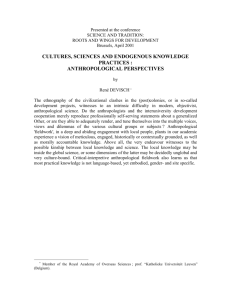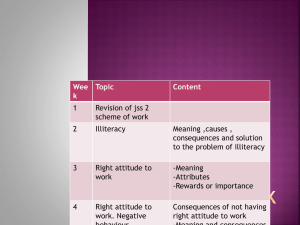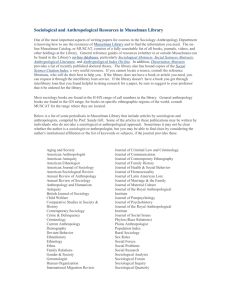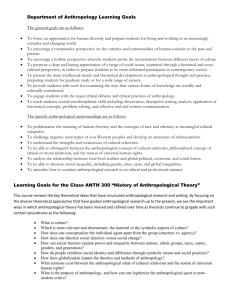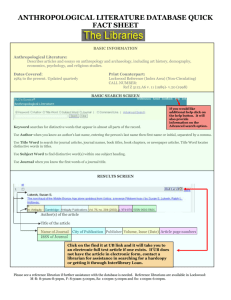Can illiteracy be eradicated
advertisement
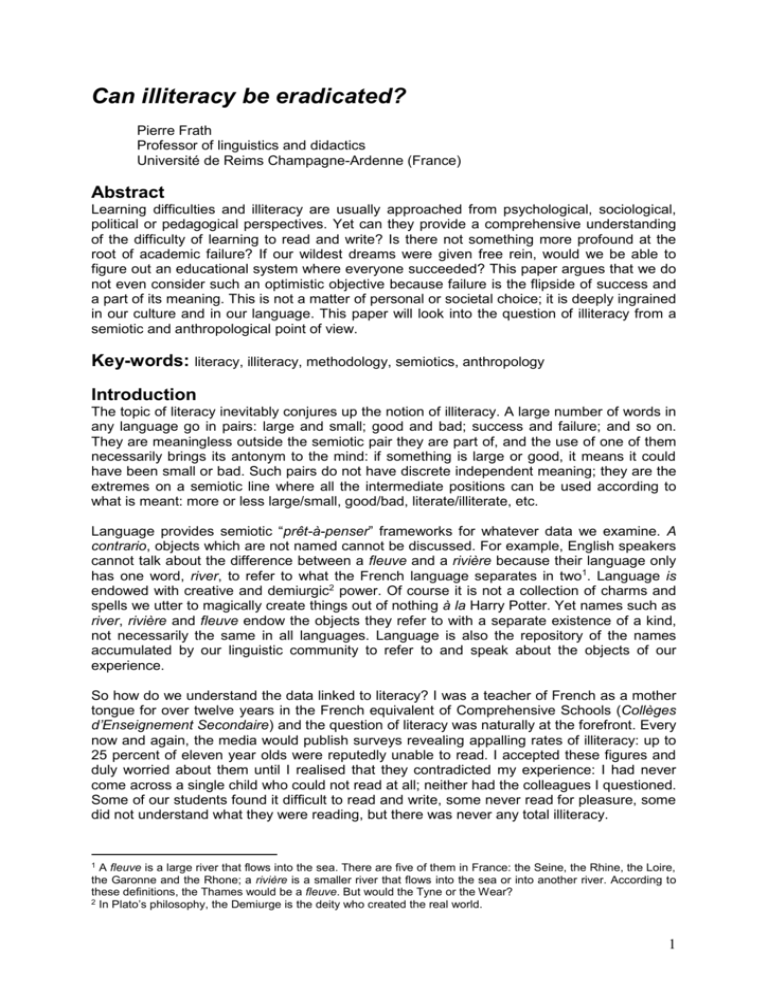
Can illiteracy be eradicated? Pierre Frath Professor of linguistics and didactics Université de Reims Champagne-Ardenne (France) Abstract Learning difficulties and illiteracy are usually approached from psychological, sociological, political or pedagogical perspectives. Yet can they provide a comprehensive understanding of the difficulty of learning to read and write? Is there not something more profound at the root of academic failure? If our wildest dreams were given free rein, would we be able to figure out an educational system where everyone succeeded? This paper argues that we do not even consider such an optimistic objective because failure is the flipside of success and a part of its meaning. This is not a matter of personal or societal choice; it is deeply ingrained in our culture and in our language. This paper will look into the question of illiteracy from a semiotic and anthropological point of view. Key-words: literacy, illiteracy, methodology, semiotics, anthropology Introduction The topic of literacy inevitably conjures up the notion of illiteracy. A large number of words in any language go in pairs: large and small; good and bad; success and failure; and so on. They are meaningless outside the semiotic pair they are part of, and the use of one of them necessarily brings its antonym to the mind: if something is large or good, it means it could have been small or bad. Such pairs do not have discrete independent meaning; they are the extremes on a semiotic line where all the intermediate positions can be used according to what is meant: more or less large/small, good/bad, literate/illiterate, etc. Language provides semiotic “prêt-à-penser” frameworks for whatever data we examine. A contrario, objects which are not named cannot be discussed. For example, English speakers cannot talk about the difference between a fleuve and a rivière because their language only has one word, river, to refer to what the French language separates in two1. Language is endowed with creative and demiurgic2 power. Of course it is not a collection of charms and spells we utter to magically create things out of nothing à la Harry Potter. Yet names such as river, rivière and fleuve endow the objects they refer to with a separate existence of a kind, not necessarily the same in all languages. Language is also the repository of the names accumulated by our linguistic community to refer to and speak about the objects of our experience. So how do we understand the data linked to literacy? I was a teacher of French as a mother tongue for over twelve years in the French equivalent of Comprehensive Schools (Collèges d’Enseignement Secondaire) and the question of literacy was naturally at the forefront. Every now and again, the media would publish surveys revealing appalling rates of illiteracy: up to 25 percent of eleven year olds were reputedly unable to read. I accepted these figures and duly worried about them until I realised that they contradicted my experience: I had never come across a single child who could not read at all; neither had the colleagues I questioned. Some of our students found it difficult to read and write, some never read for pleasure, some did not understand what they were reading, but there was never any total illiteracy. 1 A fleuve is a large river that flows into the sea. There are five of them in France: the Seine, the Rhine, the Loire, the Garonne and the Rhone; a rivière is a smaller river that flows into the sea or into another river. According to these definitions, the Thames would be a fleuve. But would the Tyne or the Wear? 2 In Plato’s philosophy, the Demiurge is the deity who created the real world. 1 If most children eventually master the art of deciphering a text, illiteracy does not mean inability to read and write but a problem with understanding and writing, i.e. learning difficulties. Yet potentially, we all experience problems with comprehension. Most people in this audience would be unable to understand articles in unfamiliar domains, e.g. particle physics, but no one is going to call us illiterate or suggest we have learning difficulties. Deciding whether someone is literate or illiterate is a judgment, and any judgment involves authority and the existence of norms. This means the question of literacy involves a range of anthropological parameters which I will now explore. In this paper, I shall examine how the question of learning difficulties has been addressed. I shall first look into psychological explanations, then political and sociological analyses, and finally education and teaching methodologies. I shall eventually propose a Wittgenstein-inspired anthropological and semiotic global view on the question of literacy. Psychological explanations Psychological explanations for learning difficulties seem quite straightforward. The basic idea is that if children fail, it is because there is something wrong in their heads, either at the biological level (a brain malfunction), or at the psychological level, or at both. Specialists have compiled lists of mental disabilities to account for learning difficulties. To name but a few: dyslexia, dyspraxia, dyscalculia, dysorthographia, dysgraphia, dysphasia … Children may also suffer from Attention Deficit Hyperactivity Disorder (ADHD) or AnxiousResistant Insecure Attachment (ARIA). They may be Aggressive Children, Daydreaming Children, Self-Absorbed or Self-Centred Children. Etc. They may be given various drugs to ameliorate their condition. Here is a definition of dysorthographia found on http://www.ravivmethod.com/3: Dysorthographia is a condition that affects the ability to acquire spelling skills. […] Symptoms of dysorthographia [include] · Slow writing, hesitations, poor vocabulary · Grammar and spelling mistakes · Arbitrary cutting of words · Omissions, merged words . This disorder can be congenital or acquired following a lesion of the nervous system. It seems Dysorthographia is the name of both a brain disorder (a faulty brain state) and a series of symptoms (behaviours in the classroom), one being the cause of the other. Dysorthographia as a whole is endowed with causal value: if a child cannot write properly, it is because he is dysorthographic. But is this legitimate and what does it explain? To begin with, is there such a thing as dysorthographia in the real world? It is doubtful. Language has us believe that what is named is endowed with separate existence (see the fleuve and rivière example). Some children experience difficulty in writing and we name this “dysorthographia”. It follows that there is such a thing as dysorthographia, and dysorthographics form a category. These dys-compounds are learned constructions coined from Greek and Latin roots and they purport to refer to clearly-identified illnesses4. As with all illnesses, it is implied that there is the possibility of a cure. Worried parents readily accept 3 Obviously written by a non-native. I have edited it for the sake of clarity. But why Latin and Greek? In Molière’s comedy “Le médecin malgré lui”, Sganarelle, an ignoramus, explains Lucinde’s dumbness with pseudo-scientific gobbledygook and dog-Latin: « … qui est causée par l’âcreté des humeurs engendrées dans la concavité du diaphragme, il arrive que ces vapeurs… Ossabandus, nequeys, nequer, potarinum, quipsa milus. Voilà justement ce qui fait que votre fille est muette » (Acte II, scène IV). 4 2 such categorisations because blaming an illness gives them hope of a solution. No doubt educationalists, psychologists and teachers will take the matter into their expert hands and do their utmost to help the children. Without those words, we would just say: “This student cannot sit still, he has difficulties in writing or reading, he is aggressive, he cannot concentrate, etc.”, i.e. discursive statements referring to a person hic et nunc, not to a category endowed with separate existence. We would not be looking for a cure; we would just think “this is how some children are”, etc. The dysorthographic child is a member of a category, not just an individual who happens to have problems with writing. But who can say that the faulty behaviours observed by teachers in the classroom are not “normal”? Maybe they are perfectly functional reactions in certain circumstances. Maybe it should be accepted that some children are slower than others. At any rate, they consist mainly in judgements passed against the background of norms. But what is the validity of norms? Who decides? Who introduces them into the school system and why? Dysorthographia and other such disorders are most probably nothing but a manifestation of what Wittgenstein called the “bewitchment of our intelligence by the means of language”5, for example an unquestioned belief that what is named has existence. As for the causal brain states which are supposed to generate dysorthographia, they are entirely hypothetical. The brain is still largely terra incognita. And even if a causal link between identified brain states and symptoms in the classroom could be established (a big if), what would it explain? What could we achieve with such knowledge? What could we do to help the children? Prescribe them drugs? Send them to hospital? Would this mean we have understood the problem? I fear this would be an extremely simplistic and naïve explanation which would eventually lead to the institutional relegation of the children. The “cures” suggested by psychological explanations are of two kinds: one is special treatment for the affected children, either medical or pedagogical; the other is the reorganisation of schools to take into account the psychological needs of children, for example by turning them into warm and welcoming places. There is certainly room for improving schools, but as they are now, they do provide a common background for the students, the same for all. The main factor explaining learning difficulties, according to psychological thought, is therefore individual student “malfunctioning”. Sociological and political explanations We shall now briefly examine Basil Bernstein’s and Pierre Bourdieu’s views. They share the notion that the educational system is not socially neutral and that it determines success for middle and upper-class children and failure for working-class children. Basil Bernstein6 makes a distinction between what he calls restricted and elaborated code. The restricted code is implicit language, based on shared assumptions, common knowledge, taken-for-granted beliefs, etc. The elaborated code, on the other hand, is explicit, more precise, syntactically and lexically richer, and spells out assumptions and knowledge. Bernstein claims that the working class tends to be excluded from the use of elaborated code. This means their knowledge will be less explicit, their language will be less precise and elaborate and will reveal their social class. As a result they tend to be excluded from the middle-classes. Pierre Bourdieu7, himself of working-class background, has worked extensively on class domination. He claims that the upper classes inflict symbolic violence on the lower classes 5Philosophical Investigations, §109 See bibliography. 7 See bibliography. 6 3 by hiding the fact that they exercise domination and that social differences are caused by economic and cultural mechanisms. He argues that one of the places where this happens is the educational system. French education claims to be based on equality (liberté, égalité, fraternité), and it is a fact that state schools offer exactly the same curricula all over the country. Funding and teacher recruitment are not normally linked to the social environment of schools or wealth of parents, even if upper-class schools tend to attract more experienced teachers and sometimes get extra funds thanks to the parents’ social networks. Yet most children remain in their original social class after the completion of their studies. This means that there is a hidden process at work which ensures the reproduction of social inequalities. According to Bourdieu, working-class students are victims of social manipulation. The school system is cleverly geared toward their failure and toward the success of the rich and well-off, even if working class children may occasionally succeed. Statistics show that there is some truth in this theory: only a very small percentage of working-class students reach university and earn a degree. Bourdieu himself was such an exception. Yet, the sociological and political explanation fails on at least one count: it requires the complicity of the school system. It implies that all teachers either participate in a silent conspiracy or fail to notice that they are being manipulated. Both alternatives stretch our credulity… The depressing conclusion with a political and sociological explanation à la Bourdieu is that nothing can be done. The “cure” can only consist in a revolution where social classes are eliminated and the school system is rebuilt on a new and more egalitarian basis. Pedagogical explanations Pedagogical explanations consider that learning difficulties originate either at the output level (teaching) or at the input level (learning), or both. To improve teaching, educationalists endeavour to design the best possible methods and to train teachers to use them. At the learning end of the process, teachers should be made aware that students may have various cognitive and learning styles, learning strategies, etc. and that they should be ready to cater for a range of student capacities. Every now and again, existing teaching methods are considered obsolete and replaced by others more in line with recently developed theories, changing political and economic circumstances, new standards, etc. But is innovation as effective as is claimed? It is doubtful: in France and in England, the average level of proficiency in foreign languages is very low8. Language learning has not improved over the past twenty years, a period which has witnessed a flourishing of pedagogical innovation. In countries where progress has been achieved, teaching methods have not been identified as the main cause of better results. Pedagogical approaches imply that the main variables are the school system and teaching. It is known that political and sociological factors do play a role but they are not considered at the pedagogical level. Student diversity is taken into account in theory, but in fact teaching methods always suppose that students are willing to participate actively in the learning process, even if it is admitted that there may be student idiosyncrasies such as laziness, low ability or lack of interest. The responsibility for failure is largely attributed to teachers: if students are not interested and do not work, it is because teachers have failed to generate interest and desire to work. The “cure” then lies in better teacher training and in the implementation of new methods, more creative classroom activities, remedial work, etc. Students who persist in failing are relegated to schools or classes catering for students with “special” needs. 8 As is clearly shown by the recently published First European Survey of Language Competences (April 2012). See http://ec.europa.eu/languages/eslc/docs/en/final-report-escl_en.pdf. 4 An anthropological approach Philippe Perrenoud9 is an educationalist who worked on the notion that achievement is not a function of student psychology. He argues that students fail or succeed when the school says so. This means that failure and success are the products of the assessment of students’ performance. Perrenoud claims that the school system has not always been as preoccupied with testing as it is nowadays. There was no special focus on assessment a few decades ago when only upper-class and some middle-class children attended further education and then went on to higher education. The status of students and their future position in society only depended marginally on academic achievements; the main factors were the parents’ wealth and social class. It is only when access to further education was extended to all the children that streaming was developed. In the UK, the Eleven Plus examination10 made sure that most working-class children went to Secondary Modern Schools11, which led to GCSE and menial jobs, while the middle-classes attended Grammar Schools, took A-Levels, went to university and enjoyed well-paid prestigious jobs. In France the situation was very similar. The evaluation process is very transparent. There is no conspiracy. Norms are accepted as a part of the learning process and assessment enjoys the support of teachers, partly because it bestows upon them social recognition and power. Efforts have been made over the past decades to formulate widely-recognised standards on which tests could be based to ensure fairer results. For example, in 1998 the Council of Europe published the Common European Framework of Reference for Languages (CEFRL), which has become the benchmark for language testing all over Europe. The methodology for writing the CEFRL and for creating the tests was extensively described, discussed and criticised, until a consensus was reached within the community of language testers. Perrenoud thinks that the hierarchy of competences produced by examinations is basically an artefact of the assessment methodology, even more transparent ones such as those based on widely-accepted frameworks of reference. He admits that student competences and capacities differ widely, but he claims that the differences are increased by the evaluation process. For example, in a CEFRL-based language exam, a question which has been failed or passed by most or all students is not considered a good question and is subsequently rejected. This means a good question is one that introduces a cleft between two groups of students, those who pass and those who fail. Perrenoud also wonders how the education system managed to gain and wield such an enormous power, and how the norms can be justified12. It seems that assessment fulfils an anthropological urge to separate the wheat from the chaff and to establish hierarchies. This seems so natural that it goes unnoticed and therefore unquestioned. Perrenoud claims that evaluation could be geared towards reducing inequalities instead of increasing them. This could have happened with the CEFRL, which was designed to evaluate skills in terms of positive achievements. Competence descriptors, also known as “can-do statements”, describe what learners can do, and not what they cannot. Here are a few B2 descriptors for Listening Comprehension: 9 See bibliography. Eleven Plus examinations were introduced in 1944. They came under heavy criticism because it was argued that they contained strong class bias. In the sixties they were redesigned to look more like I.Q. tests. This was due to the influence of Sir Cyril Burt, a psychologist who claimed he had found evidence that intelligence was innate and that education could only improve it marginally. He based his views on alleged findings on adopted twins who had been educated separately, and whose intelligence remained the same in adulthood whatever their education. It was later shown that Burt had falsified his data and his work fell into disrepute. 11 There were also Technical Schools in the “Tripartite system” created by the Butler Education Act in 1944. 12 Frameworks of reference have been criticised, e.g. Sachot (2006) and Frath (2011). Bibeau (2006) argues that Portfolios, especially electronic ones, could easily fit into a “Big Brother” sort of society where everyone could be summoned at any time to show the list of their competences. 10 5 I can understand in detail what is said to me in standard spoken language even in a noisy environment. I can understand most TV and radio broadcasts, and films if speech is standard. I can understand speech in which commonly recognized elements of humour are used. Such descriptors look quite straightforward and easy to use: can the learner understand the language in these situations? Yet, what do we mean by “understanding”? This is where the urge to separate comes back with a vengeance. At my university we are creating and introducing B2 language-tests in English, German and Spanish. We decided that the first step of their validation would be a feasibility check by colleagues who had not been involved in the creation of the tests. This is how I came to assess B2 listening comprehension tests in German, a language I speak fluently. Yet, although I understood all the items perfectly well, I failed the tests miserably: the questions were ambiguous and confusing. My colleagues could not help but introduce complexity and put the onus on intellectual capacities such as inference, deduction and being able to extract the gist from linguistic data. They were testing intelligence rather than comprehension, and they failed. A semiotic approach Bernstein’s distinction between restricted and elaborated code gives a clue as to how tests can be biased to the advantage of the middle classes: just address the student in an elaborated code. Bourdieu blames inequalities on the bourgeoisie’s desire to maintain their supremacy. Perrenoud’s anthropological explanation takes the unconscious aspect of the process into account. But how does it work? Here is some food for thought. When I was a boy, all 14-year old students used to take an exam known as the Certificat de fin d’études primaires. Most students passed it and it was subsequently phased out. Another exam, the Brevet, was introduced for 15 year-olds attending the French equivalent of Comprehensive Schools. Since it was not very selective, it never acquired much importance. Nowadays, the Baccalauréat is taken at the end of secondary education and passed by about 90 % of students within a period of two years. Instead of rejoicing about what is undeniably a significant success, pundits argue that it is not worth spending so much money on an exam which practically everyone passes. It is doubtful that the Baccalauréat as we know it has much of a future. This means that for some students to succeed, others must fail. This may sound a bit blunt but it can be shown very easily. Imagine a teacher has given an exam and all students get an excellent mark. How will this be interpreted? Certainly not as a sign of student excellence. Everyone, even the students, will conclude that the exam has been too easy or that the teacher has been too lenient. Now suppose that all the students have failed: the teacher will be blamed for proposing too difficult an exam or for being too harsh. This means that a good exam divides the class into three groups: good students, poor students, and those in between. This is an ingrained feature of the school system. Selection is programmed before a class has actually been formed and a teacher chosen to teach that class. Nor is selection related to the proficiency of students. In France, the Grandes Ecoles select their students by way of entrance examinations after a two-year preparatory course in special classes known as classes préparatoires. Only the very best students are accepted in those classes. At the end of the first year, about a third of them fail. It is the language we use to speak of success and failure, of passing and failing an exam, of literacy and illiteracy, which brings the notions they refer to into existence. 6 This means that whatever is going on in the field of evaluation has got little to do with fact. Underlying this is a semiotic and anthropological phenomenon which provides a framework for sociological and pedagogical processes of selection. For some students to succeed, others must fail, and this is the very meaning of success and failure. The question then arises of which students should fail. Western society being fundamentally unequal, other parameters (linguistic, cultural, sociological, psychological, pedagogical…) step in and produce results in accordance with the “necessity” of ensuring the reproduction of social classes, which no section of the population thinks seriously of eradicating. Can illiteracy be eradicated? Can evil be eradicated? Can poverty be eradicated? Such questions falter on ontology. What is evil? What is poverty? What is illiteracy? Now compare them to questions such as “Can this wood be cleared?” or “Can this house be pulled down?” What is the difference? We argued that language is endowed with demiurgic power. Words do not create things ex nihilo, naturally, but as was shown by the fleuve and rivière example, they give them a separate existence. In other articles (e.g. Frath 2012), I have named real-world objects such objects as wood and house, and anthropological objects such objects as illiteracy and evil. To know if an object is real-world or anthropological, just imagine the sudden disappearance of mankind. Real-world objects such as rivers, cars and houses would go on existing, at least for a while, whereas anthropological objects such as love, poverty, literacy and evil would cease to exist entirely. Anthropological names refer to cultural and linguistic objects. The problem is that names refer to real-world and anthropological objects in the same way. In both cases, objects can be talked about and knowledge then consists of discourse which expands an aspect of the object13. Yet there is a difference: all the meanings of real-world object names (such as house and wood), however metaphorical, are related in some way to physical objects, whereas with anthropological object names (such as evil and illiteracy), all the meanings refer to how the name is used in language and to a corpus of discourse that the speakers share. All speakers will easily agree on what a house is; agreement on poverty, evil and illiteracy will depend on what speakers mean, as expressed by the language they use. Anthropological objects are not deeply grounded in the real-world. On the other hand, they are deeply involved in our collective human experience. Language does not flag the anthropological or real-world nature of names. Objects referred to by words such as literacy and illiteracy, good and evil, poverty and wealth, although grounded in our experience, basically owe their existence to semiotic and anthropological features of our linguistic community. Such objects do not appear in or disappear from our consciousness by an act of will. We do not determine them, they determine us. For example, in a phrase such as “the teacher and his students”, the default use of the masculine is not caused by individual sexism and everyone accepts that such an expression says nothing about the gender of the teacher: he could be a woman. Feminists have introduced a generic use of she and her with some success. Yet most people perceive the militant stance behind it and feel it is artificial. The generic use of she will become natural and go unnoticed when it fits in with deep anthropological and societal changes in the role of women. Such changes are not decided, they just happen, they are the result of slow modifications. Language alone cannot achieve change. The sad truth is that illiteracy cannot be so easily eradicated. It would mean an anthropological and semiotic shift towards a classless and more equal society. It is possible to help individual students to succeed, for example by taking into account such or such a In what C.S Peirce call an “interpretant”, i.e. another more discursive and elaborated sign concentrating on an aspect of what he calls a “representamen”, i.e. a name (Peirce 1978). 13 7 psychological feature of theirs, or by teaching them in another way, but this will not make much of a dent in the global figures, and failure will not disappear. The literacy v. illiteracy and success v. failure dichotomies provide us with a semiotic framework on which the reproduction of hierarchies and inequalities can be based quite “naturally”, i.e. without conscious decisions, and therefore without guilt. We could not lightheartedly condone an educational system where it is clearly obvious that the failure of some children is pre-determined. This does not mean that there are no differences between humans in terms of abilities, but that such differences as there are fall into predetermined categories written in stone in the educational system. As Perrenoud said, it could be the other way round: in another type of society differences in abilities could be minimised. Wittgenstein says that “The limits of my language mean the limits of my world”14. We should always remember that nothing of what we say or think is outside our linguistic community. Even if someone were able to think something beyond the “limits of language”, they would not be able to make themselves understood. Unless of course they were in a position to create new words and have them accepted and used by the community at large. This sometimes happens when a scientist or some other expert names a newly discovered object such a as a new particle, or a new element of our collective experience, e.g. the computer mouse. The success / failure pair is a semiotic entity deeply grounded in our anthropological being. Eradicating one of them has no meaning. It would be possible for both of them to slowly wither away if our society became less unequal, if success or failure at school did not entail success or failure in the job market and in life. But it would be wise not to count on it in a foreseeable future. Meanwhile, what can we do? We should certainly go on giving our students all the help they need to achieve success. But we should also understand that failure is not only a biological, psychological or sociological anomaly. It is a structural part of our semiotic and anthropological being, and we should at least make ourselves and our students aware of this fact. Things would be clearer, and maybe in a generation or two, people would be able to imagine and work toward a fairer system with better chances for everyone. As Vaclav Havel said in Disturbing the Peace: A Conversation with Karel Hvizdala15, “Hope is a state of mind, not of the world. Hope, in this deep and powerful sense, is not the same as joy that things are going well, or willingness to invest in enterprises that are obviously heading for success, but rather an ability to work for something because it is good”. References Bernstein Basil (1975), Class, codes and control: vol. III London, Routledge. Bernstein Basil (1997), « Class and pedagogies : visible and invisible », in Culture economy and society, Halsey A.H., Lauder H., Brown P., Stuart Wells A., Oxford University Press inc., p. 59-79. Bibeau Robert (2006) : "L'usine à gaz" ou le eportfolio de "Big Brother", in Formation et Profession, juin 2006, Québec, Canada. Bourdieu Pierre et Passeron Jean-Claude (1964), Les héritiers : les étudiants et la culture, Paris, Les Éditions de de Minuit, coll. « Grands documents » (no 18). Bourdieu Pierre et Passeron Jean-Claude (1970), La reproduction : Éléments d’une théorie du système d’enseignement, Les Éditions de Minuit, coll. « Le sens commun ». Bourdieu Pierre (1979), La distinction : critique sociale du jugement, Les Éditions de Minuit. 14 15 Tractatus Logico-Philosophicus, § 5.6. English translation by Paul Wilson,1990. 8 Frath Pierre (2011) : "Le Portfolio européen des langues et le Cadre européen commun de référence : entre normalisation institutionnelle et responsabilité individuelle", in Normes et normativité en éducation. Entre tradition et rupture. Coord. Maurice Sachot et Odile Schneider-Mizony, Editions L'Harmattan, Paris, pp71-93. Egalement sur le site de l'APLV http://www.aplv-languesmodernes.org/ Frath Pierre (2012) : "There is no recursion in language". In Proceedings of the Mons International Conference on Language and Recursion, 14-16 March 2011, Mons, Belgium (forthcoming). Peirce Charles (1978) : Écrits sur le signe. Textes rassemblés, traduits et commentés par Gérard Deledalle. Seuil, Paris. Perrenoud Philippe (1989) : La triple fabrication de l’échec scolaire. In Psychologie française, n° 34/4, 1989, pp. 237-245. Repris in Pierrehumbert, B. (dir.) L’échec à l’école : échec de l’école, Paris, Delachaux et Niestlé, 1992, pp. 85-102. Maurice Sachot (2006) : "Taire le mal ou l'enseigner comme un bien", in Les Langues Modernes, n°2/2006, 54-67. Wittgenstein Ludwig (1961): Tractatus logico-philosophicus, suivi de Investigations Philosophiques. Traduit par Pierre Klossowski. NRF, Paris. Wittgenstein Ludwig (1963): Philosophical Investigations. Translated by G.E.M. Anscombe. Basil Blackwell, Oxford. 9
